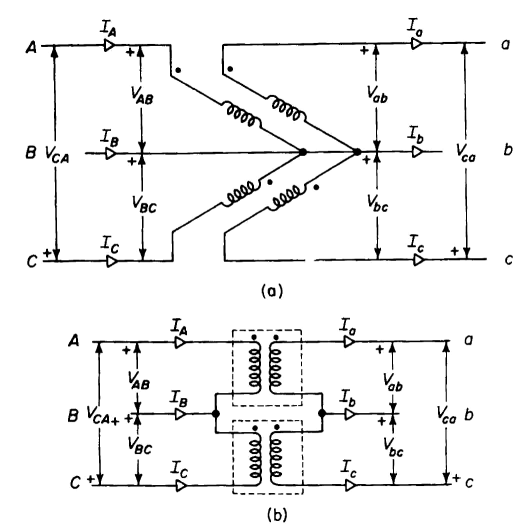| Capacitors, Magnetic Circuits, and Transformers is a free introductory textbook on the physics of capacitors, coils, and transformers. See the editorial for more information.... |

|

Home  The Transformer The Transformer  3-Phase Transformer Connections 3-Phase Transformer Connections  Open-Delta or V-V Connection Open-Delta or V-V Connection |
|||
| See also: Wye-Wye Connection, Delta-Delta Connection, Wye-Delta Connection | |||






|
|||
Open-Delta or V-V Connection
The open-delta, also known as the V-V connection, is a 3-phase arrangement that makes use of only two, instead of three, single-phase transformers, as shown in Fig. 6-27. The open-delta connection is sometimes used in the case of instrument potential transformers for economy. It is also used initially in load centers, the full growth of which may require several years, at which time a third transformer is added for the conventional delta-delta operation.
The rating of two identical transformers operating delta-delta is 1/ If it were not for the leakage impedance of the transformers, the secondary voltages of an open-delta connection would be balanced when balanced 3-phase voltage is applied to the primary. This is evident when we let VAB VBC and VCA be the balanced 3-phase primary applied voltages. Then
and
If the transformer leakage impedances are neglected, and their ratio is a, then the secondary voltages are
but from Kirchhoff's law
from which
showing that the secondary voltages Vab, Vbc, and Vca are equal in magnitude and displaced from each other by an angle of 120°. This is characteristic of balanced 3-phase systems, and is true only for ideal transformers. In the case of actual transformers, the secondary voltages will not be balanced exactly, even when balanced voltages are applied to the primary in an open-delta arrangement because there are only two transformers and, therefore, only two, instead of three, leakage impedance voltage drops.
|
|||
Home  The Transformer The Transformer  3-Phase Transformer Connections 3-Phase Transformer Connections  Open-Delta or V-V Connection Open-Delta or V-V Connection |
|||
Last Update: 2011-01-11



 of the rating of three similar transformers, but connected delta-delta. It would seem that this rating should be 2/3 instead of 1/
of the rating of three similar transformers, but connected delta-delta. It would seem that this rating should be 2/3 instead of 1/



